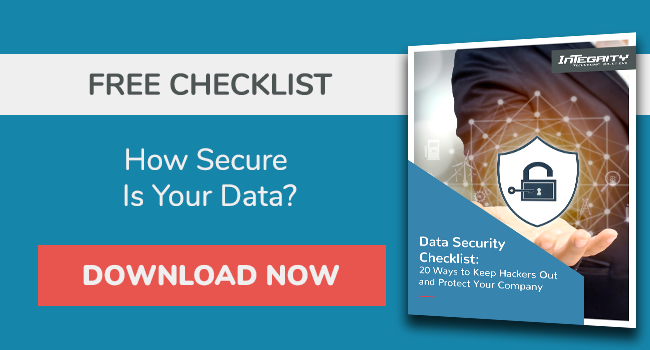Top Cybersecurity and Compliance Features with Microsoft 365

How safe is Microsoft 365?
Is your Microsoft 365 environment safe from malware and cyber attack?
Yes!
Microsoft 365 comes with cybersecurity features, including malware protection and compliance with pre-set policies, such as blocking certain file-type attachments.
But the protection doesn't come by default.
To protect your business data against cyber attacks, you need to follow the guidelines and comply with the security features of Microsoft 365.
In this article, we address the top security and compliance features included with your Microsoft 365 for Business account.
Does Microsoft 365 Provide Security?
Another way to ask this is, "How secure is your Microsoft 365 environment?”
Microsoft 365 is a highly secure platform used by over 1 million businesses worldwide.
It includes a range of robust security capabilities across four key vectors:
- Identity and access management. This protects Microsoft 365 user identities and devices and access to critical business data and resources based on risk levels.
- Threat protection. Protect users and devices against advanced threats and help the business recover quickly when under attack. Threat protection solutions include Microsoft Defender, Defender for Endpoint, and Microsoft Cloud App Security.
- Information protection. Ensure that only authorized people see emails and vital documents.
- Security and risk management. Give IT personnel control and visibility over data and information security tools.
Each of these vectors is protected by various powerful security features deployed based on your Microsoft 365 license type.
Top Security and Compliance Features
Let's look at the following top security and compliance features of Microsoft 365 for business.
Multi-Factor Authentication
Multi-Factor authentication (MFA), including 2FA, is an added layer of protection during the login process when signing in to a device, website, or application.
MFA helps verify that a user is who they say they are in more than one security feature.
For example, you can use a password with a combination of a passcode and/or biometrics (retinal or fingerprint scan) to confirm your identity and authority.
This means that even if a cyber-criminal can get your password, accessing the second security verification might be challenging, and they won't access the device, app, or website.
Microsoft 365 has two options for MFA:
- The built-in 2FA. This allows IT admins to activate users at different levels and different options for a second verification, such as passcode, biometric, etc.
- Azure MFA. This is a security add-on that companies can add to their Microsoft 365 at an additional cost to give them more control.
The company's Microsoft 365 admin, internal or external, manages its MFA policies and procedures.
Password Policies
A password policy encompasses rules that an organization's users, IT staff, and network admins must meet to enhance the device, network security, website, and data security.
These include characteristics of strong passwords (including length and the allowed/disallowed characters).
Microsoft cloud-only accounts, such as Microsoft 365 and Azure AD, contain predefined password policies that IT/network admins cannot change.
The policies include password length, complexity, and expiry duration.
In many cases, using characters like names, dates of birth, and other personal details is not recommended.
And, avoid reusing passwords for stronger password security.
Mobile Device Management (MDM)
Microsoft 365 has a provision for mobile device management, a software toolset, and a methodology to help monitor and manage mobile devices accessing sensitive enterprise data.
MDM isn't a provision to spy on employees but to control access to the company's data, including management of the bring-your-own-device (BYOD) devices.
The common MDM components include:
- Device inventor
- Tracking
- Password enforcement
- Identity and access management
- App whitelisting/blacklisting
- Endpoint security
- Remote wipe
- Encryption
A company can choose the built-in MDM for Microsoft 365 or choose Microsoft Intune for more control over enterprise data to use on mobile devices.
Defender for Microsoft 365
Microsoft 365 Defender from Microsoft is a cloud-based cyber security service designed to provide integrated protection against sophisticated attacks and malware on Microsoft 365.
It protects email protection and other Microsoft 365 protection as a unified pre- and post-breach cybersecurity defense suite.
Microsoft Defender for Office 365 is connected to Microsoft's database to analyze a business's endpoints and evaluate texts, files, or links for any potential of being malware.
Defender offers various services, including end-to-end encryption, threat protection policies, threat investigation, and reports.
Defender 365 provides three security services:
- Exchange Online Protection (EOP)
- Defender for Office 365 Plan 1 (P1)
- Defender for Office 365 Plan 2 (P2).
Encrypted Email
Microsoft 365 provides multiple encryption options for email security.
The main email encryption methods are Microsoft Purview Message Encryption, information rights management (IRM), and Secure/Multipurpose Internet Mail Extensions (S/MIME).
Encryption encodes information by transforming text into unreadable ciphertext, allowing only the authorized recipient to decode and consume it.
Microsoft 365 encryption works in two ways: in the service through TLS (used by default) and as a customer control.
In the service, encryption is used in Microsoft 365 by default; you don't have to configure anything.
For example, Microsoft 365 uses transport layer security (TLS) to encrypt the connection, or session, between two servers.
When encrypted, no individual (interceptor) other than the intended recipient can open and read the email's information.
Data Loss Prevention (DLP)
Enterprises have sensitive information/data under their control like employee information, financial data, customer data, credit card numbers, health records, and Social Security numbers.
These sensitive data need protection to reduce risk.
Protection also includes preventing users from unauthorized access and inappropriate data sharing with people who shouldn't see or have it.
This practice, process, and technologies involved in Microsoft 365 are called data loss prevention (or DLP).
The organization must protect three types of data under DLP:
- Data at rest
- Data in motion
- Data in use.
The three types of Microsoft 365 data loss prevention capabilities: are network DLP, endpoint DLP, and cloud DLP.
Implementing a DLP policy will help you automate the process of identifying, monitoring, and protecting sensitive data/devices across different areas, including:
- Microsoft 365 tools such as SharePoint, Teams, Exchange, and OneDrive.
- Microsoft Office applications like Word, Excel, Access, PowerPoint, and Outlook.
- Operating systems: Windows 10, Windows 11, and macOS (Catalina 10.15 or higher).
- On-premises SharePoint and on-premises file shares.
- Non-Microsoft-based cloud apps
Creating and managing DLP policies in the Microsoft 365 Compliance center helps stay compliant with business security and industry regulations.
Advanced Threat Protection (ATP)
Microsoft 365 Defender has an Advanced Threat Protection (ATP) tool that helps enterprise-class businesses detect and respond to advanced security threats.
ATP is an investigative response feature for threat prevention and post-detection threats like phishing and business email compromises.
ATP identifies and stops malicious links, websites, or email attachments before they can be accessed.
This helps to keep the organization's website, network, emails, and data safe from such advanced threats.
ATP is a Microsoft 365 add-on available in most licenses, such as Office 365 Enterprise E5.
Microsoft 365 Plans for Your Business
Microsoft 365 Business has four plans that have different features. The plans are:
- Microsoft 365 Business Basic. This is an ideal plan for SMBs and comes with OneDrive and SharePoint for collaboration as well as Office 365 desktop apps (Word, Excel, PowerPoint, etc.)
- Microsoft 365 Apps for Business. This plan gives businesses access to the latest Microsoft Office tools on mobile and desktop for productivity and collaboration. The apps under this plan are Word, OneNote, Word, Outlook, Excel, PowerPoint, Publisher, Teams, OneDrive, SharePoint, and Access.
- Microsoft 365 Business Standard. This plan offers what is in the Microsoft 365 basic, Microsoft 365 Apps, and cloud services. It also has other advanced services that target specific audiences, such as access to professional email and online storage.
- Microsoft 365 Business Premium. This corporate plan can serve SMBs of up to 300 users. It's the best-in-class productivity suite for accessing Microsoft cloud services and has security for ATP. It also has important add-ons like Windows 365, audio conferencing, and business voice.
You need to select the right Microsoft 365 plan based on the size of your business, the features you want, and the security level you need.
See a more detailed description of Microsoft 365 Business plans here.
Conclusion
Businesses store and use sensitive data that needs protection from employee exposure and cyber threats.
If you're using Microsoft's business software (any plan), we believe the cyber security and compliance features we've mentioned will help you tighten your organization's security and threat protection.
If you're unsure of your business's current security position to use the best security protection, use this free 20-point data security checklist to find out the gaps in your cybersecurity strategy.

